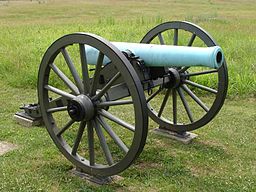Battle ofGettysburg
| Battle of Gettysburg | |||||||
|---|---|---|---|---|---|---|---|
| Part of the American Civil War | |||||||
 The Battle of Gettysburg, by Thure de Thulstrup |
|||||||
|
|||||||
| Belligerents | |||||||
|
|
|
||||||
| Commanders and leaders | |||||||
| George G. Meade | Robert E. Lee | ||||||
| Units involved | |||||||
| Army of the Potomac | Army of Northern Virginia | ||||||
| Strength | |||||||
| 104,256 ("present for duty") | 71,000–75,000 (estimated) | ||||||
| Casualties and losses | |||||||
|
23,049 total
(3,155 killed;
14,529 wounded; 5,365 captured/missing) |
23,000–28,000 (estimated) | ||||||
| Battle of Gettysburg | |
| Protected area | |
|
M1857 12-Pounder "Napoleon" at Gettysburg National Military Park Gettysburg, Pennsylvania.
|
|
| Country | United States |
|---|---|
| State | Pennsylvania |
| County | Adams |
| Municipalities |
Cumberland, Franklin Straban |
| Campaign Theater |
Gettysburg Eastern |
| Landmark | High Water Mark monument @ The Angle on Cemetery Ridge |
| Owners | private, federal |
| Website: Park Home (NPS.gov) | |
| Images | |
|---|---|
|
|
|
|
|
|
|
|
|
| Video | |
|
|
The Battle of Gettysburg (locally /ˈɡɛtᵻsbɜːrɡ/, with an /s/ sound) was fought July 1–3, 1863, in and around the town of Gettysburg, Pennsylvania, by Union and Confederate forces during the American Civil War. The battle involved the largest number of casualties of the entire war and is often described as the war's turning point. Union Maj. Gen. George Meade's Army of the Potomac defeated attacks by Confederate Gen. Robert E. Lee's Army of Northern Virginia, ending Lee's attempt to invade the North.
After his success at Chancellorsville in Virginia in May 1863, Lee led his army through the Shenandoah Valley to begin his second invasion of the North—the Gettysburg Campaign. With his army in high spirits, Lee intended to shift the focus of the summer campaign from war-ravaged northern Virginia and hoped to influence Northern politicians to give up their prosecution of the war by penetrating as far as Harrisburg, Pennsylvania, or even Philadelphia. Prodded by President Abraham Lincoln, Maj. Gen. Joseph Hooker moved his army in pursuit, but was relieved of command just three days before the battle and replaced by Meade.
...
Wikipedia

